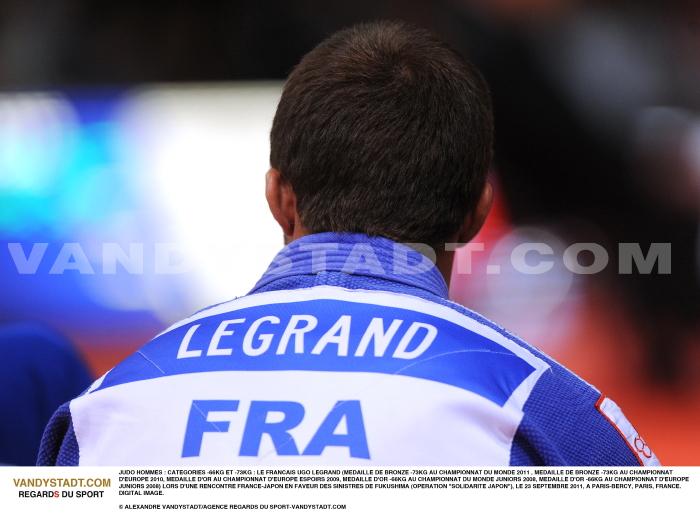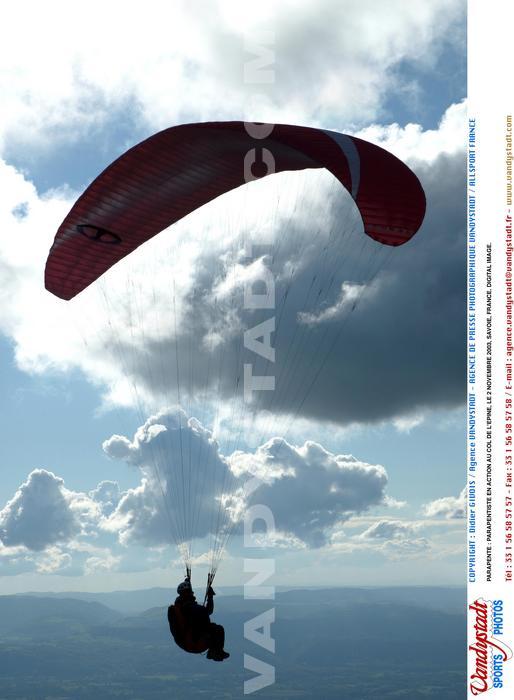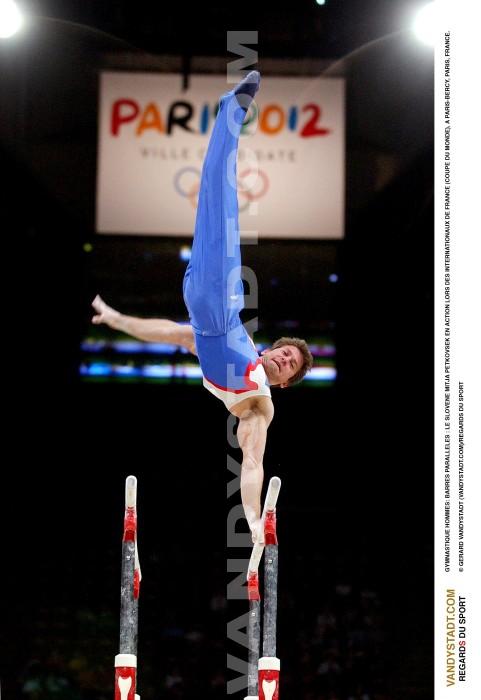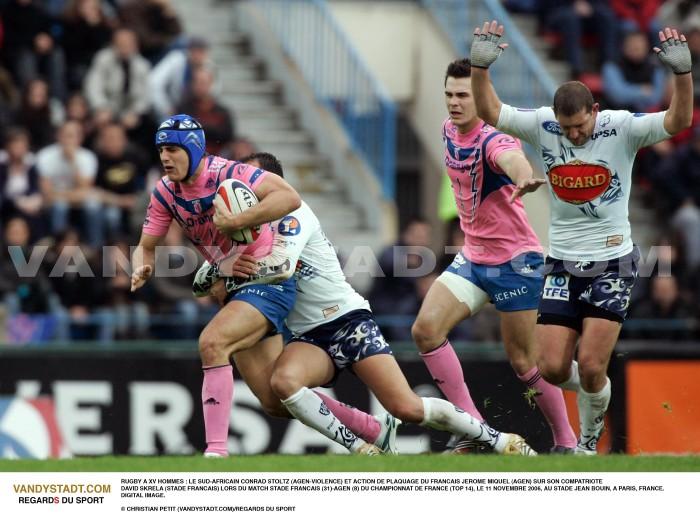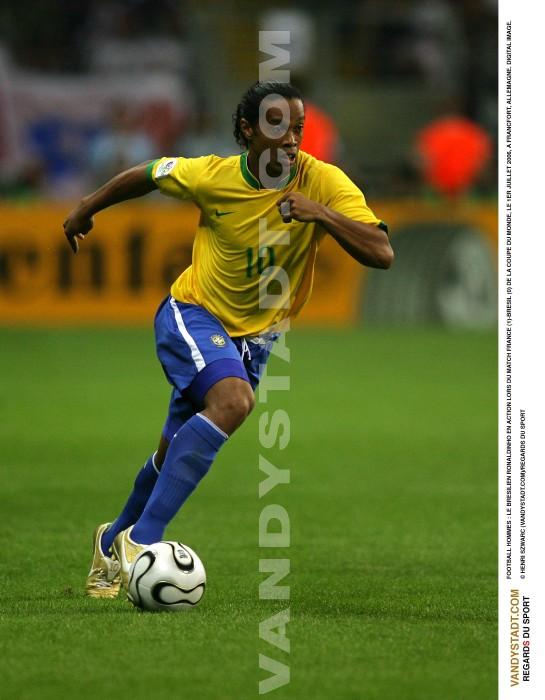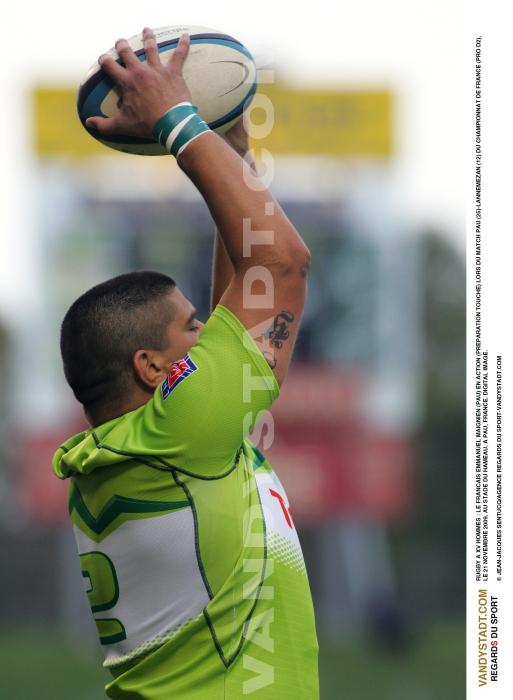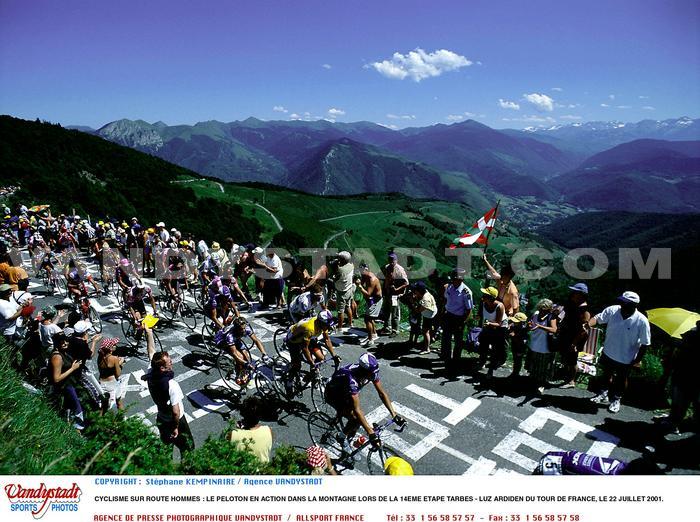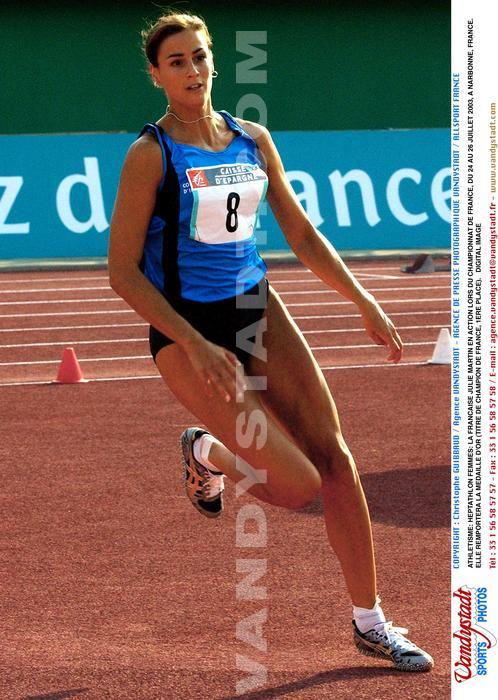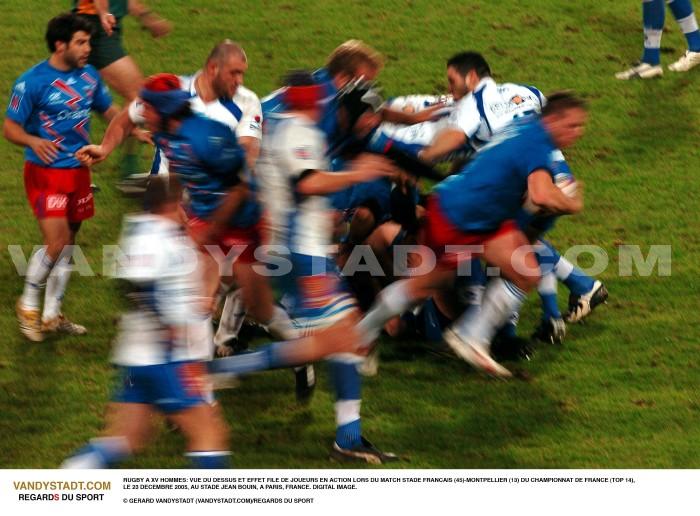Football américain - American Football history
American Football / Rugby XI
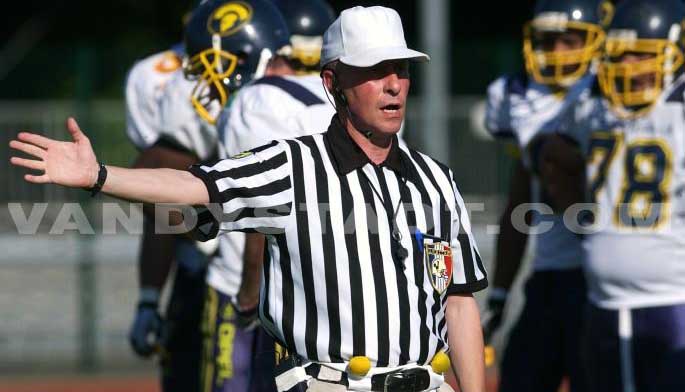
History
At Princeton (New Jersey) in 1867, and students tired of soccer (football "European") and gaming league, decided to create the most perfect sport possible synergy of physical and mental.
This variant of football was known as Princeton Rules. This November 6 this year takes place the first game between Princeton Rutger.
But it still matches between the universities of Harvard and Yale, circa 1875, this game closer than the one we know today.
1876 saw the creation of
the Intercollegiate Football Association Which improves the structural rules (introduction of scrimmage, the muddle ...). In 1879, one of the great peculiarities of American football makes its appearance: the block (obstruction opponent not carrying the ball). From 1880, football will give more accurate structures with Walter Camp was one of the players from Harvard in 1876. The quarterback (quarterback) makes his entrance as well as the eleven players on each side. In 1882, the system attempts (downs) and yards to win is born. In 1883 the marking system of points is introduced and that same year the American Football is codified. In 1902 the creation of the classic finals championship university: the "Rose Bowl (Pasadena, California). The year 1912 marks a turning point. dimensions of land passed from 130 to 120 yards. A fourth attempt (down) is added to make ten yards. In 1920, the American Professional Football Association was formed. Chaired by Jim Thorpe, star of 1913, she became in 1922 the National Football League (NFL). The first major contract of the young NFL is signed by the famous Harnold "Red" Great receiving $ 50,000 of the Chicago Bears for a promotional tour for eleven days. It is already well below the $ 500 first professional fee, perceived by some Heffelfinger in 1892. But in 1950 the NFL was thrown into the spheres of high finance. That same year, she spent her first contract with the TV. In this way, football is as the No. 1 sport in the United States. The NFL is becoming a thriving business and envied. Thus in 1960, the American Football League (AFL) is formed. Strengthening to big shot celebs university attracted the bundles of greenbacks, she quickly takes important dimensions. But the rival leagues are facing bankruptcy if an agreement is not found.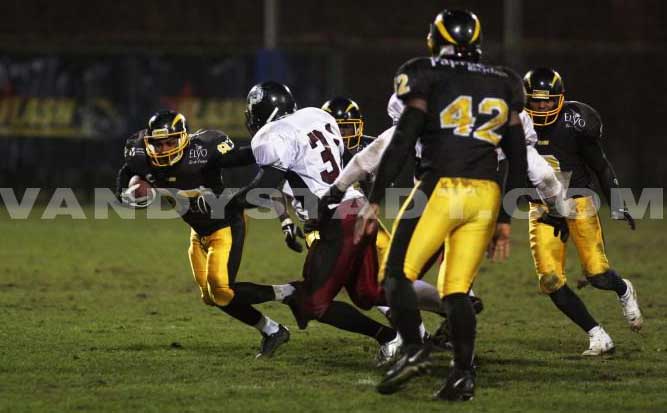
NFL also managed to negotiate a merger: in 1967, the NFL champion meets the AFL champion. So the SuperBowl, the grand finale American professional, was born. This game between the Packers at Green Bays Kansas City Chiefs Superbowl is called 1. Unity is strength.
The modern NFL is born.
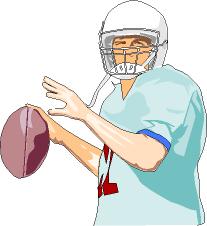
History of football in France
1980: The football made its entry into France through the initiative of a physical education teacher: Lawrence Plegelatte, former national junior rugby and judo teacher who discovered the sport during a trip to Denver Colorado in 1980. Enthused, he returned to France with 24 facilities ... The first training sessions were held with a group of friends at Pershing Stadium in Vincennes. Gradually the team is expanding, Laurent Plegelatte form of players and created the first American Football Club French: Paris's Spartacus. New clubs appear then, as the Meteors of Nogent, the Blue Angels of Montreuil, the Dogfish La Malmaison.
In 1985, the frenzy of American Football has won the province and 37 clubs are affiliated to the FFFA with 1022 redundant. 10 Clubs are registered at Golden Helmet to Helmet and 16 Silver. 17 Clubs participating in the 2nd Cup of France and 10 in the first FIFA Midi. The French Federation of American Football was born May 6, 1985. In 1993, the Ministry of Youth and Sports recognizes the football as a sport of High Level.
At the General Assembly in December 1999, the French Federation of American Football has decided to extend its name to "rugby XI.
13 000 redundant - 66 clubs
French teams :
Around Paris:
- The Molossians Asnières
- Meteora Fontenay-sous-Bois
- The Templars Elancourt
- The Voltigeurs Soisy-sur-Ecole
- The Musketeers Plessis
- The flashes of La Courneuve
By Province
- The Argonauts of Aix-en-Provence
- Orcs Châteauroux
- The Iron Mask de Cannes
- The Black Panthers Thonon.
- The Spartans of Amiens
- Comets Toulouse
In 2007, French football has 6500 U.S. and 200 licensed clubs.
Principles and rules
Principle
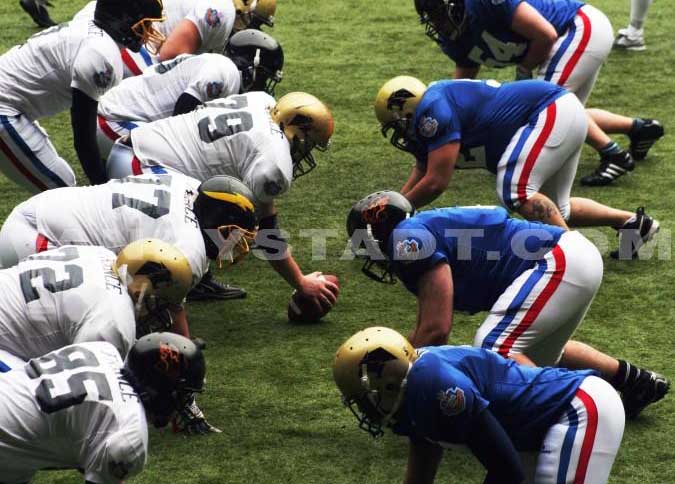
American football is a game of "win-ground". The goal is to bring the ball into the in-goal.
Each team consists of a formation of attack and defense training of 11 players each.
The attacking team must advance the ball into the area in-goal opponent (end zone) to be marked and the defense team must prevent this progression.
It has several attempts to grow by at least 10 yards (9.10 meters), this distance is marked on the ground by white lines. The opposing team (the "defense" is also composed of 11 players) must try to stop him, pressing the ball carrier to be attacking in turn.
One of the essential foundations of football lies in the fact that the teammates of the ball carrier can protect and promote its growth by blocking the players of the opposing team. Thus, more than any other team sport, the role players to attack not carry the ball, which is to open the way into the enemy lines for the ball carrier and the plating protect against a possible, is paramount.
Players attack can impede the progress of their opponents by percussion and blocks made with shoulders, forearms, hands between the shoulders and hips.
Prohibited: seizures, capital of defensemen, punches, elbow, knee, head and blocking in the back are totally prohibited and severely punished.
There are generally 5 to 7 arbitrators on the playground can recognize their jacket striped black and white. The chief referee (referee) always has a white cap. They are responsible for ensuring compliance and proper functioning of the party by reporting errors by white flags.
Field
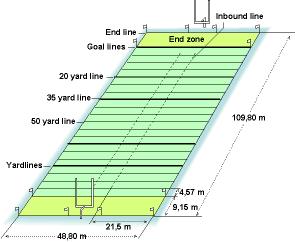
It is along 100 yards (91.50 m) areas in-goal and wide range of 53.3 yards (48.8 m). A transverse white line is drawn every 5 yards (4.57 m). The areas in-goal, 10 yards wide (9.15 m), are overseen by the posts (to order), which are located on the bottom line (7.12 m, height 3 m).

In Europe, the game can accommodate football or rugby standard (100 m between the poles).
The balloon
It looks like rugby. The ball is leather and weighs 400 grams. It has two white stripes to make it more visible.
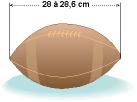
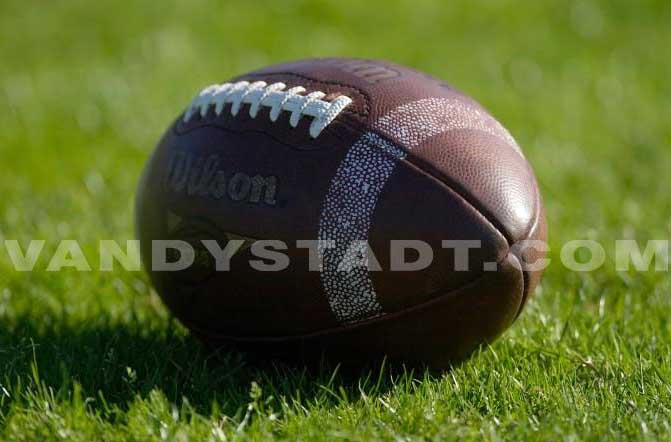
Equipment
The impressive holding of players is also subject to a very strict regulation. Its role is only protector and it must contain any material likely to injure the opponent. Are required: helmet, mouth guard, shoulder, hip protection, knee and thigh, protects tailbone and shoe spikes. Optional: protection of the elbow.
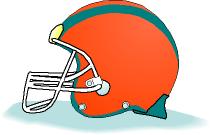
1976: the year of prohibition to block the opponent's helmet. Since then, serious accidents have dropped ..
The number of players
The maximum number of potential players is not limited. A team consists of approx. 45 players (to choose the 11 players who are on the ground) divided into three groups. They specialize either in attack or defense, or special training (kicking a penalty and clearance, etc.).
The numbering of the players is as follows:
1 to 19: quarterback and kickers.
20 to 49: Running backs and defensive.
50 to 59: linebackers and centers.
60 to 79: Players of the interior offensive line (linemen).
80 to 89: recipients.
90 to 99: defensive linemen.
Replacements not limited in number, are allowed once the game is decided between two phases of play
A player sent off by referee may be replaced by another, but in no case return the field to participate in the game
The duration of the game
A meeting is divided into four quarter-time of 15 minutes (actual time), with a half-time of 20 minutes between the second and third quarter. Between the first and second quarter and between the third and fourth quarter, the teams change ends without the situation of the game is changed (eg the game lying on the line 20 yards from the defense team, it extends the same position on the line for 20 yards against it.) 3 timeouts per half is allowed. Downtime and stoppages of play does not count. An average game lasts 2 hours and 45 minutes.
The main rules
Technicalities
American football is played in France under the rules of "college football.
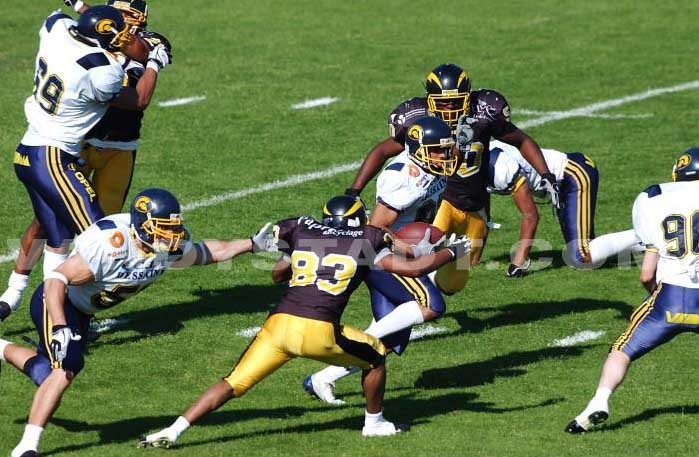
Brand
(goals are the same as in rugby)
There are three ways to score points:
- Moved / test (touchdown): 6 points
- Transformation in hand: 2 points.
- Transformation foot: 1 point
- Kick precision goal (field goal): 3 points
- Moved security (safety) or tackle in his own in-goal for a player of the attacking team with the ball: 2 points.
The attack
The rule requires the attacking team to position at least 7 players on the line put into play (line of scrimmage).
Only players placed at the end of the line brought into play (called ends) or positioned behind at least 1 m from this line are eligible to receive a pass before.
The rule states that players must be motionless attack one seconds before the full implementation of the actual play ball.
Only an attacker may be in motion before putting into play only on condition that his course is parallel or behind the line put in.
2 million practitioners in the United States.
Defense
Defenders can be positioned or moving as they see fit. The only requirement imposed on them is not to cross the line into play prior to actual play the ball.
Commitment: kick-off
A kick commitment is made at the beginning of the 1st and 3rd quarter of the time since the 30 yard line.
This can not kick out directly into touch, on pain of penalty.
We start the kick of engagement with a decline of 5 yards of the team's kicker.
The ball must then pass at least 10 yards to be involved
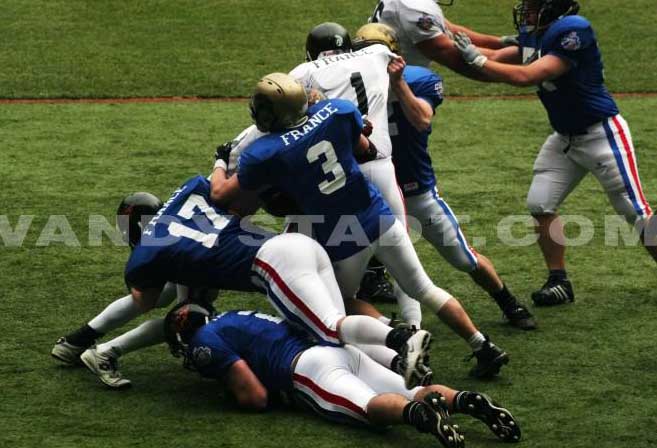
The game
After the kick of engagement, the defense team who caught the ball at a specific location, lots of land and is replaced by the attacking team takes possession of the ball and starts the game at the place or the ball was caught.
The attacking team must move the ball 10 yards (9.15 m minimum) required in 4 (down) maximum, to retain possession and continue to grow. In case of failure or if the ball was recovered by the opposing defense team, after a loose ball (fumble), intercepted a pass, it gives the ball to the team of opponent's attack and brought on his training ground defense. If a team attack has not made sufficient progress during the first three bound, it then has the opportunity, during the 4th required to generate a kick (punt). By the same token, it gives the ball to his opponent.
Between each light, the captain gathered his team on the field for a conference (huddle). This short collection of 25 seconds allows the master to communicate with his team's tactical choice. Currently, a French team usually has about thirty "games". In absolute terms, the number varies at infinity.
To move forward, the attacking team uses mainly races with the ball in hand and assists. A single pass is allowed by prior light. During races, it is entitled to as many passes back and sides as necessary. In addition, it can employ kicked off or kicked the goal (field goal).
These increases, which may seem confusing, are actually very strict application of tactics and games that were previously developed and extensively repeated during training.
American football and rugby
We often compare American football to rugby because they share the concept of veneer. The big difference is that rugby is forbidden to flatten the ground a player in possession, while in 10 American football players are devoted to block other players to avoid a pass. Also rugby anyone can touch the ball while in American football players all play a very specialized position.
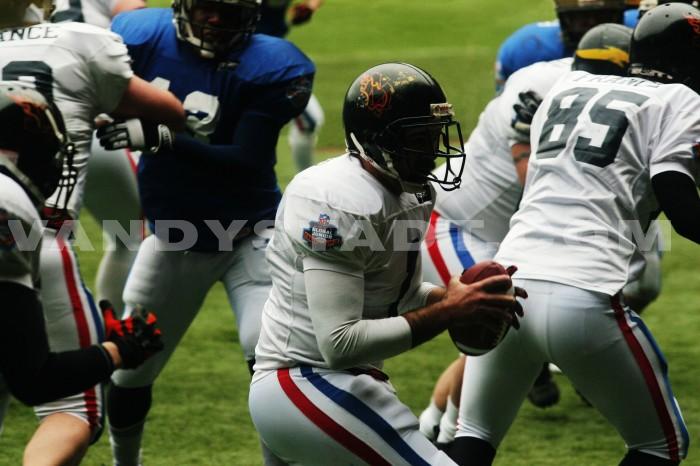
Penalties
American football is a game of wins ground, penalties expressed in lost ground for the team's offense.
There are penalties of 5, 10 and 15 yards (in some cases the expulsion of players is applied).
Major penalties:
- Offside: 5 yards (illegal departure of a player before placing the ball in play)
- Delay of Game: 5 yards (the attack takes more than 25 seconds to start the ball)
- Illegal movement of an attacker: 5 yards
- Holding a player by the jersey: 10 yards.
- Block in the back, illegal: 10 yards.
- Obstruction Pass for 15 yards and loss of light.
- Unsportsmanlike conduct (punch, calling): 15 yards to the expulsion of the team and player.
The main role of defenders to stop the enemy advance, involves projecting the ground the ball carrier through a tackle.
The flag football
The flag is a form of American football but without contact and less restrictive and open to all ages, men and women alike.
Each player has a 'flag' or flag hanging on the shorts, which must remain hanging. This is to limit contact with the enemy severe. The equipment is less expensive.
The sport takes the majority of the rules of American Football.
The major differences are:
- There is no veneer: the game stops when we removed the flag (flag) of the belt carrying the ball.
- Teams consist of 7 players.
- The field is narrower.
There are currently twenty teams of flag football in France comprised of youth aged 10 to 16 years.
The 2006 World Championships saw the sanctity of France in men (by beating Denmark) and women (beating Japan).
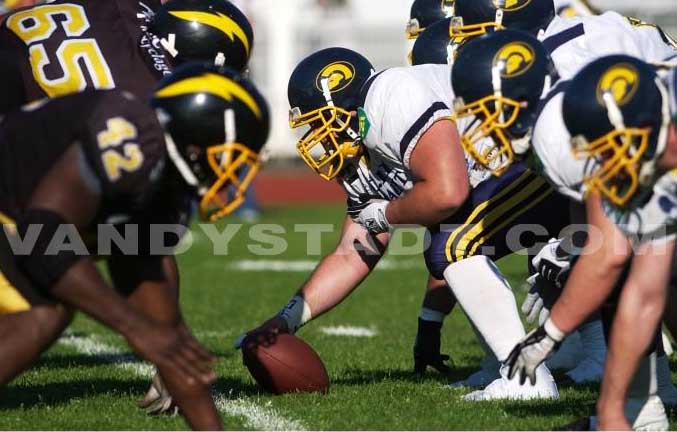
Glossary
American football, like any sport has a language peculiar to itself. Despite sounding American is able to easily understand the meaning of terms used.
Attack (in English "offense") unit in possession. It has the responsibility to keep progressing towards embutir (opposing goal line).
Blitz: pressure from the defensive to the attack. The blitz was conducted by the online secondary (linebackers) or the defensive backs (cornerbacks and safeties).
Clipping: fault secure made illegal in the back of an opponent. This fault occurs mostly on kick-offs, on punts, and interceptions.
Corner back (CB): cornerback or defensive back, charged to mark sensors password (2 players).
Defense: Unit ball without charge to stop the progression of the opposing team.
Defensive end: defensive end (2 players).
Down: attempt. The attack on four consecutive downs (first to fourth) to move ten yards (9.14 m).
Draft: annual meeting of leaders of the NFL clubs. It consists of recruiting the best college players.
End zone: area ten yards (9.14 m) located at each end of the field embutir.
Extra Point: a kick to touch down processing (1 point).
Field goal: precision kick worth three points (drop). The ball must pass between the opposing poles.
Free safety: half of security. Back.
Full Back: blocker, runner.
Fumble: ball escaped, recovered.
Guard: Guard, 2 players.
Hand off: direct delivery of the ball between the quarterback and running.
Head Coach: The general who runs a hundred people per team (env.65 players in uniform, 12 coaches, 30 assistant coaches, doctors, physiotherapists, etc..).
Holding: fault. Holding an opponent with his hands.
Huddle: short collection tactics made 25 seconds on the field by two teams from each game
-Inside linebacker: interior defensive curtain (2 players).
Interception: change of possession occurs when a fielder catches a pass intended for an offensive player.
Interference: fault occurred when a defensive player or offensive bothers potential recipient.
Kick off: kickoff made early in each half and after each touchdown.
Linebacker: The key player of the defense. It must stop opposing races and penetrate enemy lines.
Line judge: linesman.
Lineman: Defender Primary
Man to man: against the pass defense of assigning a defender to each potential recipient.
Nose tackle: Defensive blocker.
Offensive tackle: blocker.
Outside linebacker: outside linebacker or defensive side curtain (2 players).
Pass rush: made defensive pressure on the quarterback situation in password.
Pitch: short pass back, "Password rugby."
Punt: punt or kick clearance used primarily in fourth down, with the normal outcome is a change of possession.
Quarterback: Quarterback. Playmaker who organizes and distributes the game
Reverse: Thu surprise in which the quarterback hands the ball to a player running in the opposite direction.
Rookie: beginning of first year.
Running back: halfback, runner.
Sack: tackle the quarterback before he is "get rid" of the ball.
Safety: A safety occurs when the ball carrier is dumped in his own end zone. This is the last bulwark of defense
Scrimmage: line where each action begins.
Split ends: winger away.
Strong safety: rear security.
Sweep: Thu overflow.
Tackle: Blocker (2 players).
Tight end: catcher and blocker.
Time out: stoppage called by the referee team. Each team is allowed three times out of 90 seconds from halftime.
Touch down: the equivalent of test rugby. A touchdown occurs when a player in possession of the ball crosses the goal line opposite.
Umpire: J. melee.
Wide receiver: wide receiver (2 players).
Zone: type of defense against the pass of covering some of the ground and not a particular player.
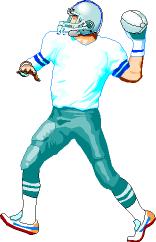
Copyright Sportquick/Promedi








